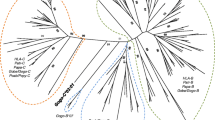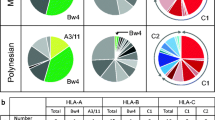Abstract
The role of natural killer (NK) cells is tightly modulated by interactions of killer cell immunoglobulin-like receptors (KIR) with their ligands of the MHC class I family. Several characteristics of the KIR gene products are conserved in primate evolution, like the receptor structures and the variegated expression pattern. At the genomic level, however, the clusters encoding the KIR family display species-specific diversity, reflected by differential gene expansions and haplotype architecture. The human KIR cluster is extensively studied in large cohorts from various populations, which revealed two KIR haplotype groups, A and B, that represent more inhibitory and more activating functional profiles, respectively. So far, genomic KIR analyses in large outbred populations of non-human primate species are lacking. In this study, we roughly quadrupled the number of rhesus macaques studied for their KIR transcriptome (n = 298). Using segregation analysis, we defined 112 unique KIR region configurations, half of which display a more inhibitory profile, whereas the other half has a more activating potential. The frequencies and functional potential of these profiles might mirror the human KIR haplotype groups. However, whereas the human group A and B KIR haplotypes are confined to largely fixed organizations, the haplotypes in macaques feature highly variable gene content. Moreover, KIR homozygosity was hardly encountered in this panel of macaques. This study exhibits highly diverse haplotype architectures in humans and macaques, which nevertheless might have an equivalent effect on the modulation of NK cell activity.





Similar content being viewed by others
References
Abi-Rached L, Moesta AK, Rajalingam R, Guethlein LA, Parham P (2010) Human-specific evolution and adaptation led to major qualitative differences in the variable receptors of human and chimpanzee natural killer cells. PLoS Genet 6(11):e1001192-e. https://doi.org/10.1371/journal.pgen.1001192
Aghaei H, Mostafaei S, Aslani S, Jamshidi A, Mahmoudi M (2019) Association study between KIR polymorphisms and rheumatoid arthritis disease: an updated meta-analysis. BMC Med Genet 20(1):24. https://doi.org/10.1186/s12881-019-0754-6
Alecsandru D, Garrido N, Vicario JL, Barrio A, Aparicio P, Requena A et al (2014) Maternal KIR haplotype influences live birth rate after double embryo transfer in IVF cycles in patients with recurrent miscarriages and implantation failure. Hum Reprod 29(12):2637–2643. https://doi.org/10.1093/humrep/deu251
Blokhuis JH, van der Wiel MK, Doxiadis GG, Bontrop RE (2010) The mosaic of KIR haplotypes in rhesus macaques. Immunogenetics 62(5):295–306. https://doi.org/10.1007/s00251-010-0434-3
Bruijnesteijn J, de Groot N, van der Wiel MKH, Otting N, de Vos-Rouweler AJM, de Groot NG et al (2020a) Unparalleled rapid evolution of KIR genes in rhesus and cynomolgus macaque populations. J Immunol 204(7):1770–1786. https://doi.org/10.4049/jimmunol.1901140
Bruijnesteijn J, de Groot NG, Bontrop RE (2020b) The genetic mechanisms driving diversification of the KIR gene cluster in primates. Front Immunol 11:582804. https://doi.org/10.3389/fimmu.2020.582804
Bruijnesteijn J, de Groot NG, Otting N, Maccari G, Guethlein LA, Robinson J et al (2020c) Nomenclature report for killer-cell immunoglobulin-like receptors (KIR) in macaque species: new genes/alleles, renaming recombinant entities and IPD-NHKIR updates. Immunogenetics 72(1–2):37–47. https://doi.org/10.1007/s00251-019-01135-8
Bruijnesteijn J, van der Wiel M, de Groot NG, Bontrop RE (2021) Rapid Characterization of Complex Killer Cell Immunoglobulin-Like Receptor (KIR) Regions Using Cas9 Enrichment and Nanopore Sequencing. Front Immunol. https://doi.org/10.3389/fimmu.2021.722181
Bruijnesteijn J, van der Wiel MKH, de Groot N, Otting N, de Vos-Rouweler AJM, Lardy NM et al (2018a) Extensive alternative splicing of KIR transcripts. Front Immunol. https://doi.org/10.3389/fimmu.2018.02846
Bruijnesteijn J, van der Wiel MKH, Swelsen WTN, Otting N, de Vos-Rouweler AJM, Elferink D et al (2018b) Human and rhesus macaque KIR haplotypes defined by their transcriptomes. J Immunol 200(5):1692. https://doi.org/10.4049/jimmunol.1701480
Cisneros E, Moraru M, Gómez-Lozano N, Muntasell A, López-Botet M, Vilches C (2020) Haplotype-based analysis of KIR-gene profiles in a South European population-distribution of standard and variant haplotypes, and identification of novel recombinant structures. Front Immunol 11:440. https://doi.org/10.3389/fimmu.2020.00440
de Brito Vargas L, Beltrame MH, Ho B, Marin WM, Dandekar R, Montero-Martín G et al (2021) Remarkably low KIR and HLA diversity in Amerindians reveals signatures of strong purifying selection shaping the centromeric KIR region. Mol Biol Evol 39(1). https://doi.org/10.1093/molbev/msab298
Gómez-Lozano N, Estefanía E, Williams F, Halfpenny I, Middleton D, Solís R et al (2005) The silent KIR3DP1 gene (CD158c) is transcribed and might encode a secreted receptor in a minority of humans, in whom the KIR3DP1, KIR2DL4 and KIR3DL1/KIR3DS1 genes are duplicated. Eur J Immunol 35(1):16–24. https://doi.org/10.1002/eji.200425493
Gonzalez-Galarza FF, McCabe A, Santos Eduardo J Md, Jones J, Takeshita L, Ortega-Rivera Nestor D et al (2019) Allele frequency net database (AFND) 2020 update: gold-standard data classification, open access genotype data and new query tools. Nucleic Acids Res 48(D1):D783-D8. https://doi.org/10.1093/nar/gkz1029
Gourraud PA, Meenagh A, Cambon-Thomsen A, Middleton D (2010) Linkage disequilibrium organization of the human KIR superlocus: implications for KIR data analyses. Immunogenetics 62(11–12):729–740. https://doi.org/10.1007/s00251-010-0478-4
Graef T, Moesta AK, Norman PJ, Abi-Rached L, Vago L, Older Aguilar AM et al (2009) KIR2DS4 is a product of gene conversion with KIR3DL2 that introduced specificity for HLA-A*11 while diminishing avidity for HLA-C. J Exp Med 206(11):2557–2572. https://doi.org/10.1084/jem.20091010
Guethlein LA, Norman PJ, Heijmans CMC, de Groot NG, Hilton HG, Babrzadeh F et al (2017) Two orangutan species have evolved different KIR alleles and haplotypes. J Immunol 198(8):3157. https://doi.org/10.4049/jimmunol.1602163
Hernandez EG, Partida-Rodriguez O, Camorlinga-Ponce M, Nieves-Ramirez M, Ramos-Vega I, Torres J et al (2018) Genotype B of killer cell immunoglobulin-like receptor is related with gastric cancer lesions. Sci Rep 8(1):6104. https://doi.org/10.1038/s41598-018-24464-2
Hiby SE, Walker JJ, O’Shaughnessy KM, Redman CW, Carrington M, Trowsdale J et al (2004) Combinations of maternal KIR and fetal HLA-C genes influence the risk of preeclampsia and reproductive success. J Exp Med 200(8):957–965. https://doi.org/10.1084/jem.20041214
Hollenbach JA, Nocedal I, Ladner MB, Single RM, Trachtenberg EA (2012) Killer cell immunoglobulin-like receptor (KIR) gene content variation in the HGDP-CEPH populations. Immunogenetics 64(10):719–737. https://doi.org/10.1007/s00251-012-0629-x
Hou L, Chen M, Ng J, Hurley CK (2012) Conserved KIR allele-level haplotypes are altered by microvariation in individuals with European ancestry. Genes Immun 13(1):47–58. https://doi.org/10.1038/gene.2011.52
Jiang W, Johnson C, Jayaraman J, Simecek N, Noble J, Moffatt MF et al (2012) Copy number variation leads to considerable diversity for B but not A haplotypes of the human KIR genes encoding NK cell receptors. Genome Res 22(10):1845–1854. https://doi.org/10.1101/gr.137976.112
John E, Christiansen FT, Mueller I, Schofield L, Senitzer D, Siba P et al (2012) Distinct distribution of killer-cell immunoglobulin-like receptor genes in the Mugil and Ilaita areas of Papua New Guinea. Tissue Antigens 79(4):263–271. https://doi.org/10.1111/j.1399-0039.2012.01848.x
Johnsen GM, Størvold GL, Drabbels JJM, Haasnoot GW, Eikmans M, Spruyt-Gerritse MJ et al (2018) The combination of maternal KIR-B and fetal HLA-C2 is associated with decidua basalis acute atherosis in pregnancies with preeclampsia. J Reprod Immunol 129:23–9. https://doi.org/10.1016/j.jri.2018.07.005
Khakoo SI, Thio CL, Martin MP, Brooks CR, Gao X, Astemborski J et al (2004) HLA and NK cell inhibitory receptor genes in resolving hepatitis C virus infection. Science 305(5685):872–874. https://doi.org/10.1126/science.1097670
Kulkarni S, Martin MP, Carrington M (2008) The Yin and Yang of HLA and KIR in human disease. Semin Immunol 20(6):343–352. https://doi.org/10.1016/j.smim.2008.06.003
Lanier LL (2005) NK cell recognition. Annu Rev Immunol 23:225–74. https://doi.org/10.1146/annurev.immunol.23.021704.115526
Lin Z, Kuroki K, Kuse N, Sun X, Akahoshi T, Qi Y et al (2016) HIV-1 Control by NK cells via reduced interaction between KIR2DL2 and HLA-C(∗)12:02/C(∗)14:03. Cell Rep 17(9):2210–2220. https://doi.org/10.1016/j.celrep.2016.10.075
Littera R, Piredda G, Argiolas D, Lai S, Congeddu E, Ragatzu P et al (2017) KIR and their HLA Class I ligands: two more pieces towards completing the puzzle of chronic rejection and graft loss in kidney transplantation. PLoS One 12(7):e0180831. https://doi.org/10.1371/journal.pone.0180831
Ljunggren HG, Kärre K (1990) In search of the ‘missing self’: MHC molecules and NK cell recognition. Immunol Today 11(7):237–244. https://doi.org/10.1016/0167-5699(90)90097-s
Marsh SG, Parham P, Dupont B, Geraghty DE, Trowsdale J, Middleton D et al (2003) Killer-cell immunoglobulin-like receptor (KIR) nomenclature report, 2002. Hum Immunol 64(6):648–654. https://doi.org/10.1016/s0198-8859(03)00067-3
Martin MP, Bashirova A, Traherne J, Trowsdale J, Carrington M (2003) Cutting edge: expansion of the KIR locus by unequal crossing Over. J Immunol 171(5):2192. https://doi.org/10.4049/jimmunol.171.5.2192
Matzaraki V, Kumar V, Wijmenga C, Zhernakova A (2017) The MHC locus and genetic susceptibility to autoimmune and infectious diseases. Genome Biol 18(1):76. https://doi.org/10.1186/s13059-017-1207-1
McQueen KL, Dorighi KM, Guethlein LA, Wong R, Sanjanwala B, Parham P (2007) Donor-recipient combinations of group A and B KIR haplotypes and HLA class I ligand affect the outcome of HLA-matched, sibling donor hematopoietic cell transplantation. Hum Immunol 68(5):309–323. https://doi.org/10.1016/j.humimm.2007.01.019
Misra MK, Augusto DG, Martin GM, Nemat-Gorgani N, Sauter J, Hofmann JA et al (2018) Report from the killer-cell immunoglobulin-like receptors (KIR) component of the 17th International HLA and Immunogenetics Workshop. Hum Immunol 79(12):825–833. https://doi.org/10.1016/j.humimm.2018.10.003
Norman PJ, Abi-Rached L, Gendzekhadze K, Hammond JA, Moesta AK, Sharma D et al (2009) Meiotic recombination generates rich diversity in NK cell receptor genes, alleles, and haplotypes. Genome Res 19(5):757–769. https://doi.org/10.1101/gr.085738.108
Ordóñez D, Gómez-Lozano N, Rosales L, Vilches C (2011) Molecular characterisation of KIR2DS2*005, a fusion gene associated with a shortened KIR haplotype. Genes Immun 12(7):544–551. https://doi.org/10.1038/gene.2011.35
Ordóñez D, Meenagh A, Gómez-Lozano N, Castaño J, Middleton D, Vilches C (2008) Duplication, mutation and recombination of the human orphan gene KIR2DS3 contribute to the diversity of KIR haplotypes. Genes Immun 9(5):431–437. https://doi.org/10.1038/gene.2008.34
Parham P (2005) MHC class I molecules and kirs in human history, health and survival. Nat Rev Immunol 5(3):201–214. https://doi.org/10.1038/nri1570
Parham P, Moffett A (2013) Variable NK cell receptors and their MHC class I ligands in immunity, reproduction and human evolution. Nat Rev Immunol 13(2):133–144. https://doi.org/10.1038/nri3370
Parham P, Norman PJ, Abi-Rached L, Guethlein LA (2012) Human-specific evolution of killer cell immunoglobulin-like receptor recognition of major histocompatibility complex class I molecules. Philos Trans R Soc Lond B Biol Sci 367(1590):800–811. https://doi.org/10.1098/rstb.2011.0266
Pyo CW, Guethlein LA, Vu Q, Wang R, Abi-Rached L, Norman PJ et al (2010) Different patterns of evolution in the centromeric and telomeric regions of group A and B haplotypes of the human killer cell Ig-like receptor locus. PLoS One 5(12):e15115. https://doi.org/10.1371/journal.pone.0015115
Pyo C-W, Wang R, Vu Q, Cereb N, Yang SY, Duh F-M et al (2013) Recombinant structures expand and contract inter and intragenic diversification at the KIR locus. BMC Genomics 14(1):89. https://doi.org/10.1186/1471-2164-14-89
Shilling HG, Lienert-Weidenbach K, Valiante NM, Uhrberg M, Parham P (1998) Evidence for recombination as a mechanism for KIR diversification. Immunogenetics 48(6):413–416. https://doi.org/10.1007/s002510050453
Solloch UV, Schefzyk D, Schäfer G, Massalski C, Kohler M, Pruschke J et al (2020) Estimation of German KIR allele group haplotype frequencies. Front Immunol 11(429). https://doi.org/10.3389/fimmu.2020.00429
Uhrberg M, Valiante NM, Shum BP, Shilling HG, Lienert-Weidenbach K, Corliss B et al (1997) Human diversity in killer cell inhibitory receptor genes. Immunity 7(6):753–763. https://doi.org/10.1016/s1074-7613(00)80394-5
Vendelbosch S, de Boer M, van Leeuwen K, Pourfarzad F, Geissler J, van den Berg TK et al (2015) Novel insights in the genomic organization and hotspots of recombination in the human KIR locus through analysis of intergenic regions. Genes Immun 16(2):103–111. https://doi.org/10.1038/gene.2014.68
Vierra-Green C, Roe D, Hou L, Hurley CK, Rajalingam R, Reed E et al (2012) Allele-level haplotype frequencies and pairwise linkage disequilibrium for 14 KIR loci in 506 European-American individuals. PLoS One 7(11):e47491-e. https://doi.org/10.1371/journal.pone.0047491
Wilson MJ, Torkar M, Haude A, Milne S, Jones T, Sheer D et al (2000) Plasticity in the organization and sequences of human KIR/ILT gene families. Proc Natl Acad Sci U S A 97(9):4778–4783. https://doi.org/10.1073/pnas.080588597
Acknowledgements
We thank Prof. Dr. A. Sanchez-Mazas and Dr. J. M. Nunes from the Anthropology Unit of the Department of Genetics and Evolution (University of Geneva, Switzerland) for their advice on pairwise gene linkage analysis. We also thank D. Devine for editing the manuscript and F. van Hassel for preparing the figures.
Funding
This work was supported in part by the NIH/NIAID contract number HHSN272201600007C.
Author information
Authors and Affiliations
Contributions
NdG and AdV-R performed all practical work. NdG, AdV-R, and JB analyzed the data. JB wrote the manuscript. NGdG and RB supervised the project and edited the manuscript.
Corresponding author
Ethics declarations
Competing interest
The authors declare no competing interests.
Additional information
Publisher's Note
Springer Nature remains neutral with regard to jurisdictional claims in published maps and institutional affiliations.
Supplementary Information
Below is the link to the electronic supplementary material.
Rights and permissions
About this article
Cite this article
Bruijnesteijn, J., de Groot, N., de Vos-Rouweler, A.J.M. et al. Comparative genetics of KIR haplotype diversity in humans and rhesus macaques: the balancing act. Immunogenetics 74, 313–326 (2022). https://doi.org/10.1007/s00251-022-01259-4
Received:
Accepted:
Published:
Issue Date:
DOI: https://doi.org/10.1007/s00251-022-01259-4




